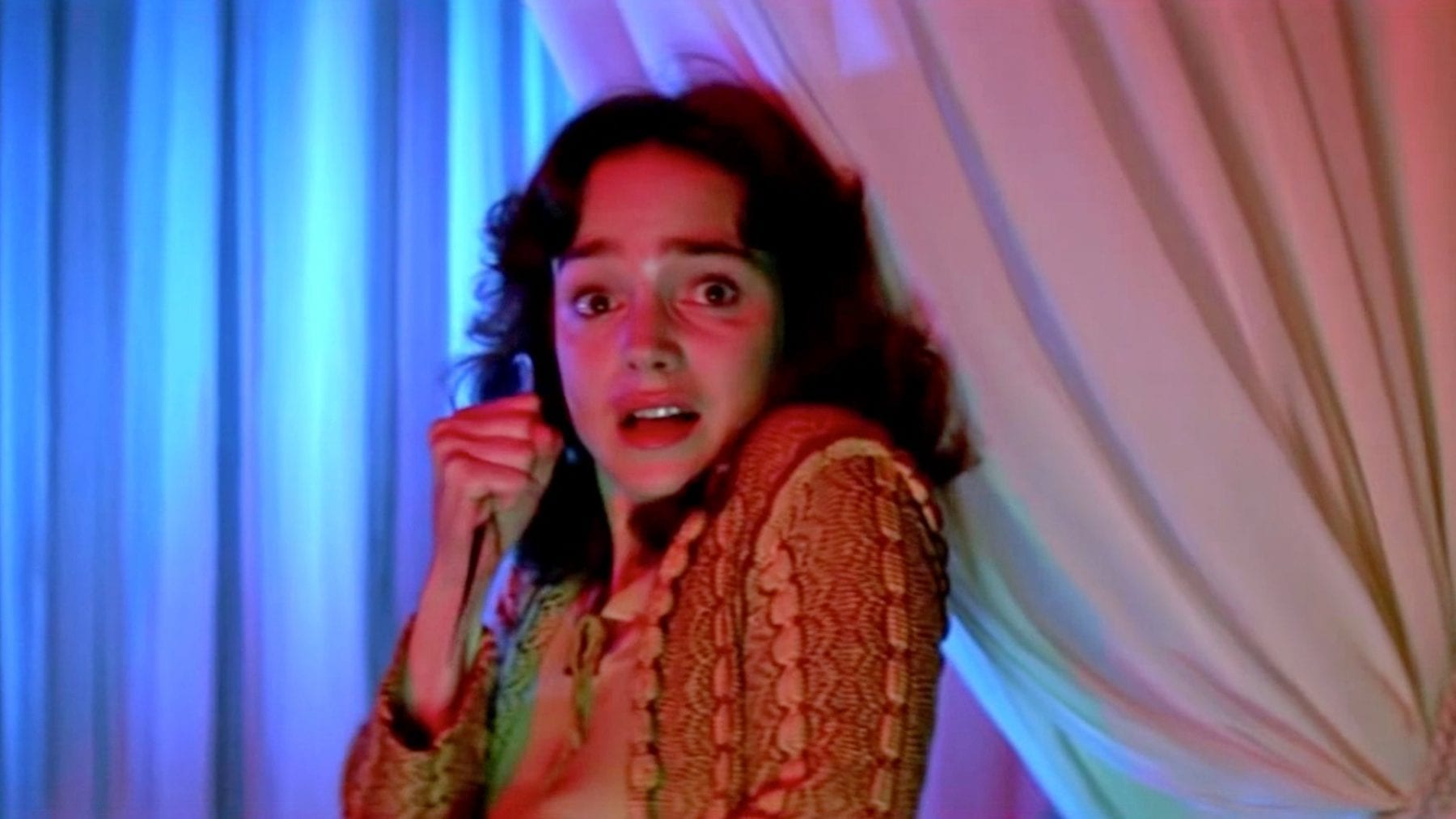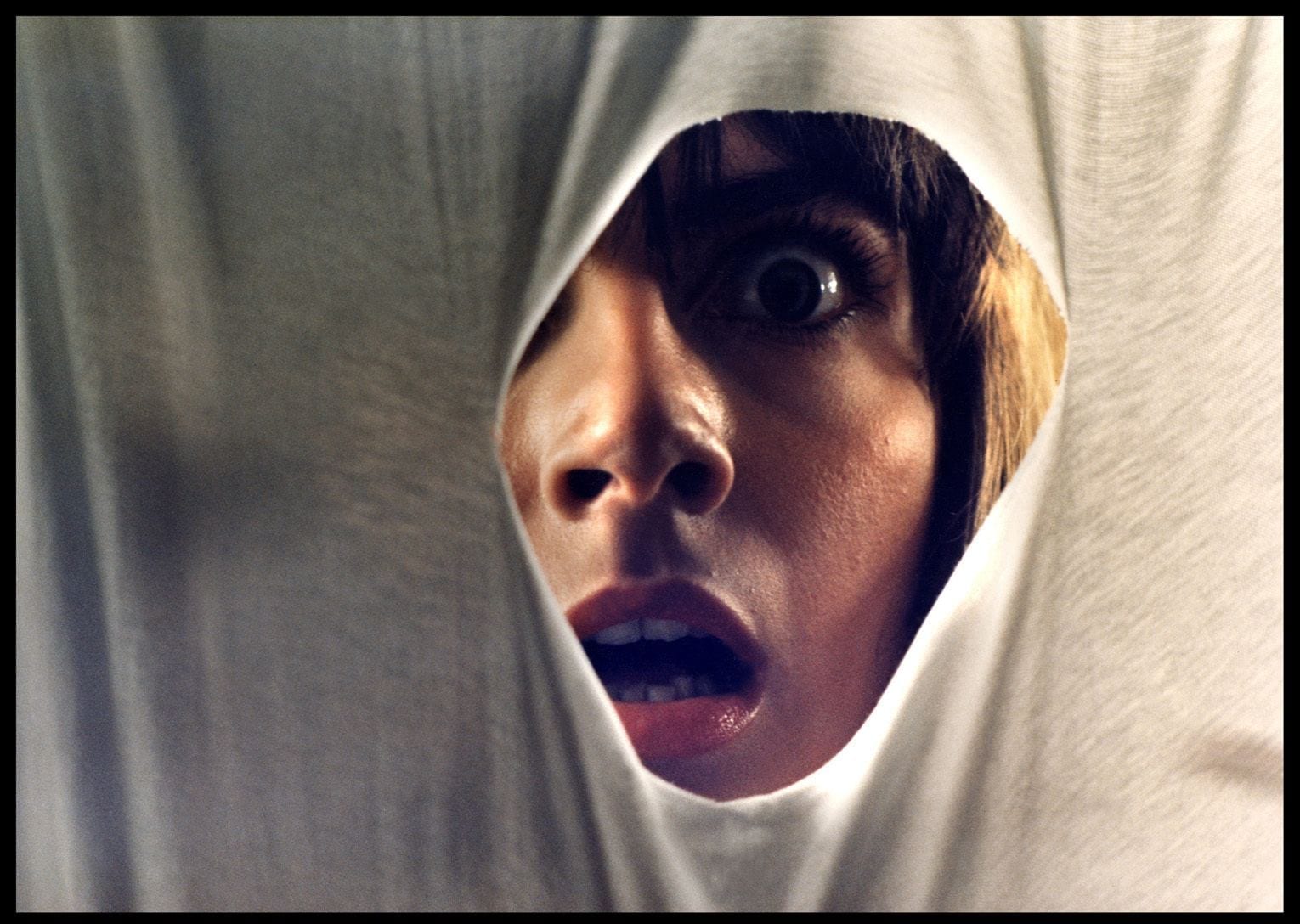There are certain moments in my life where a filmmaker, through their work, changes everything I thought I knew about the medium. David Lynch is one of these directors; there was the kid before I saw Blue Velvet (1986) and then there was the kid after. Dario Argento is one of these filmmakers. The first time I encountered the “master of horror” completely altered the way I perceived film. Suspiria (1977) told a story with sight and sound in a manner that I had never encountered before. The film contained colors that seemed to pop off the screen and held a hallucinatory aura that presented more questions than it ever answered. My young mind had never heard noises like the ones being used—a cacophonous terrifying symphony of shrieks and screams over dissident, ominous chords. The music itself by Goblin was revelatory. Dario Argento’s films, especially in the 70s and 80s, proved him to be an unrivaled master of the genre, a horror icon.
Narrative wasn’t always the first and foremost thing on Argento’s mind; some argue that the Italian horror maestro is all style and no substance. There may be some truth to this argument, but when I watch Argento’s work, I’m always drawn in by how he tells the story as much as I am the story itself. This incomparable visual flair serves him well when his narratives sometimes get too convoluted. Dario Argento’s filmmaking is a master class in style. He started out his career as a director heavily influenced by Alfred Hitchcock—who heavily influenced the Italian genre giallo—a thriller / detective story that often contains proto slasher or even supernatural elements. The giallo genre is also known for its shocking death scenes.
Birth Of The Giallo, “Animal Trilogy,” And Deep Red

Mario Bava and other Italian directors had made giallo films like Blood and Black Lace (1964), but Dario Argento really cemented the giallo as his own force in Italian film with first directed feature The Bird With The Crystal Plummage (1970). This film set the tone for much of what followed in the giallo genre. Dario Argento created a whole subgenre; he was influenced by Hitchcock and especially Bava, but took what they had done a huge step forward. Argento brought a level of highly stylized violence that giallo films had not previously contained. He also turned up the suspense immensely.
The Bird With the Crystal Plummage was a smash in Italy and was duplicated by Italian filmmakers over and over throughout the 1970s. Argento’s first film showcased a lot of the things that would become trademarks throughout his entire career; there’s a black-gloved killer stalking and brutally murdering young women. There’s a young (often) Italian man helping the police solve the mystery of the killer’s identify after accidentally witnessing a murder. The killer is dealing with some sort of past trauma that has driven them to become a murderer in a psychotic break. John Carpenter, another “master of horror” stated that Argento’s early giallo films, particularly Deep Red (1975) heavily inspired Halloween (1978).
Argento’s film-making arrival not only set off a firestorm of other Italian directors churning out giallos, but it was also the start of his most prolific period. Between 1970-1975, he would release four giallo films. Three our of four were known as the “animal trilogy.” The second after Bird was The Cat O’ Nine Tails, a film that has always reminded me of Argento’s spin of Hitchcock’s The Man Who Knew Too Much (1956). The third, Four Flies on Grey Velvet (1972), added an even thicker layer of hallucinatory flare to the proceedings but the “animal trilogy” had all the aforementioned giallo elements. The visual style in these movies is truly what keeps me coming back.
Throughout the “animal trilogy,” Argento employed film techniques and a style that—while influenced by others—seemed wholly his own. The camera was everything; POV shots put me in the mind of the character. Long tracking shots of characters meeting, sharing details and discussing leads about the unfolding case made me feel like a delicious fly in a room I shouldn’t be in. The films are full of quick cuts and heavily rely on visual cues to carry the scenes as opposed to exposition
One that particularly sticks out is from Cat O’Nine Tails wherein one of the main characters in the film visits a barber he knows quite well during the investigation for a routine shave. The way that Argento films the action, through quick cuts of the blade being wiped clean after each swipe of the neck as the bartender tells the story fills an otherwise normal scene with dread. There’s just no way to create that on the page.
That is such a memorable scene—it is pure Argento. The camera continuously cuts from the character in the barber seat clenching the newspaper in fear, to his worried eyes, back to the blade being cleaned, back to the throat and the sound of the sharp swipe as he shaves the worried man. Over top of all the camera cuts building the tension is the barber calmly telling the character that he has heard the police may think the killer could be a barber and it couldn’t be a barber because a barber would most certainly slice someone’s throat. That’s probably the last thing you want to hear when sitting in a barber chair with your neck totally exposed. I walk away from that scene understanding it perfectly without Argento putting a linen of dialogue in the disturbed patron’s mouth. I know because of the way Argento shows me with his camera.
The horrific death scenes throughout giallo also became a staple…and Argento was always outdoing himself. He especially seemed to like to give it to the villains at the end in gut wrenching way. In Cat O’ Nine Tails, the killer horrendously falls down an elevator shaft to his death, but the camera is from his point of view, so my stomach drops every single time. All I can hear are his screams; all I can see are his hands burning up as he tries to grab the ropes before the angle abruptly changes and the elevator shaft meets him. I feel that fall every time. Argento makes that fall feel like it’s my fall.
So what happens to the killer wife at the end of Four Flies on Grey Velvet? She drives off into the night to only be decapitated when she accidentally crashes into a construction truck in front of her. The scene is played with a terrifying slow motion sense of beauty that switches from first person to a closeup of her face in slow motion before she is decapitated. Both films end abruptly the moment the villain is killed, leaving me and the audience with a sickening jolt.
After completing his “animal trilogy,” Argento left the world of giallo that he helped establish for two years, making two TV dramas and one period comedy that was only released in Italy. In 1975, Argento returned to up the giallo game to full on horror with Profondo Rosso aka Deep Red, cementing his legacy as thrill master once and for all. This film is an absolute masterpiece. Previously working with composer Ennio Morricone to fantastic results—this time he teamed up with the band Goblin led by Claudio Simonetti. The score would be nothing short of astronomical. Adding a layer of dread, darkness, and continuing the trademark shift in personality and voyeuristic tendencies of his camera, Argento made the greatest giallo film of all time. Deep Red is still unrivaled to this day.
Suspiria

The Goblin score to Suspiria (1977) is my favorite film score of all time. It is hypnotic; I had never heard anything like it before. I’ve heard it described as prog rock, but it’s so much more than that. The haunting melody, the ominous unholy whispers and the cries of “witch!” transported me directly into the film. There’s so much going on in the opening sequence, my pick for greatest opening sequence of all time. Right from the start I felt dropped in a world full of magic and superstition that was beautiful and dangerous—something I could also never fully understand. There were witches and killers behind every corner powered by some ancient evil. The vibrant colors mixed with the atmosphere altering Goblin title theme to lead up to the scariest murder in horror history; it is truly a thing to behold.
There’s very little dialogue in the opening of Suspiria and the entirety of it feels like a dream. A young American dance student lands in Italy to attend a prestigious dance school—before I even realize it—the journey has already begun and it doesn’t let up until the credits roll. Argento blew the doors off the hinges with Suspiria. Once again, the narrative was fine enough but the way in which he told his bewitching story seemed like it came signed and sealed by Satan herself.
The film relies heavily, to great effect, on the beautiful cinematography full of rich colors and the reddest blood ever put on screen. And that Goblin score…it’s in a word, perfect. From the start of the film and the horrific murder of a young girl…the colors of the film, the bewitching Goblin score, and the brutality of the kills make it one of the greatest films in all of horror history.
Suspiria told a tight, perfectly executed story that interwoven magic, secrecy and terror with a mostly female cast plunged against an ancient evil. If that isn’t enough to hook any horror fan than the best stylistic film-making you’ve ever seen combined with the best damn score in the horror genre should sell anyone. Suspiria is one of those films that has never been duplicated by Argento or anyone else. I’m also well aware of the remake. I surprisingly found it to be amazingly effective and one of my favorite films of any genre last year; that’s a different tale for a different article.
If Deep Red cemented Dario Argento as the king of the giallo, then Suspiria ushered in a new master of horror. If he would have never made another film, Dario Argento’s place in the horror hall of fame would already be his. Suspiria turned out to not only be the biggest and most important film of his career, but would also kick off the Three Mothers trilogy,including the sequels Inferno (1980) and The Mother of Tears (2007.) Both films have their fans—myself being one of them—but neither captured the madness and perfection of Suspiria.
Tenebrae, Opera, Demons, and Later Works

Moving into the ’80s after continuing his Three Mothers Trilogy with Suspiria sequel Inferno, Dario Argento left full on supernatural horror for a return to the giallo genre that he helped invent with another masterpiece. Tenebrae, in my opinion, is the best film he ever made overall from an objective standpoint. It has all the trademark elements of his classic films and the “Louma crane sequence” was cited as a direct influence by Brian de Palma on his famous “step sequence” from his classic crime thriller The Untouchables (1987). Tenebrae was written off at the time of its release as a lesser Dario Argento late-period giallo, but it has eventually been recognized as the classic it truly is.
Tenebrae was a personal film for Argento. Throughout the years the abrasive and brutal nature of his giallo and horror films had earned him a reputation in certain circles as someone who hated women and loved to see them tortured and murdered in his work. He was accused of everything from being a pervert to a deviant voyeur. Obsessed fans and angry ex-fans would stalk Argento, one even leaving death threats to the supposed psychological damage he had suffered being a former fan of Dario’s work. Argento put all of this into his film and more to chilling effect; once again, members of Goblin were on board for the score.
Dario Argento has been plagued in the later years of his filmmaking life with bad film after bad film, disappointing both fans and critics alike. Sometimes I think the bad reviews are justified; sometimes I think he’s just become an easy target for people to hate. Of his later work I’d be remiss without recommending Sleepless (2001) and The Stendhal Syndrome (1996) especially. Also, both of his episodes of Showtime’s Masters of Horrors are worth watching as well. In 2007 he was finally able to finish the Three Mothers Trilogy as well with the generally well-received The Mother of Tears. The made for TV film Do You Want to Watch Some Hitchcock? (2005) is also worth a watch.
Does Argento have plenty of cinematic failures? Sure. At all costs avoid Dracula 3D (2012), Giallo (2009), and The Card Player (2004) especially. These films are best unspoken of so that’s the only mention they’ll receive in this piece. Going back to the ’80s, Argento still had one more masterpiece up his sleeve. In 1987, he gifted the entire cinematic world with the film Opera. Though the film had an extremely troubled production, it would go down as one of his best and his last true master stroke to date.
Opera is Dario Argento’s own giallo spin on the classic tale of The Phantom of the Opera. Never mind the terrible straight adaptation of Phantom he would regrettably make 11 years later.
Like Tenebrae, Argento used familiar elements he had established way back at the dawn of the ’70s in Opera, but as an older man with more experience he smartly added more of himself into his work. The character Marco (Ian Charleson) was based on Dario Argento himself and his failed attempts at directing a stage version of Verdi’s MacBeth. This and Tenebrae both not only worked for me but also worked for audiences on release as they were two of his biggest financial successes. The score was once again outstanding, done by Brian Eno, Bill Wyman, and Goblin main stay Claudio Simonetti.
Outside of directing, Argento has always been a screenwriter; his start actually came in Sergio Leonne’s classic ‘spaghetti’ Western, Once Upon a Time in the West (1968). In 1987, the same year of the release of his classic Opera, Argento wrote both Demons and its sequel Demons 2 for Mario Bava’s son, Lamberta Bava—coming full circle and passing the torch in the world of Italian horror cinema. The first Demons aka Demoni is one of the big box VHS blind purchases I made as a kid and is one of my favorite surrealistic horror films to this day.
Demons is heavy metal splatter horror, but Dario Argento’s fingerprints are all over it. He also collaborated with my other favorite filmmaker George A. Romero on Romero’s 1978 Dawn of the Dead. The film was released in Italy as Zombi, re-edited by Argento with a much shorter runtime and more Goblin music. The two would collaborate again ten years later with the Edgar Allan Poe adaptation Two Evil Eyes.
There has been a passing down of the torch throughout Italian horror history. Mario Bava started the giallo in the early ’60s, inspired to make Blood and Black Lace from such giallo and slasher progenitors as Peeping Tom (1960) and the works of Alfred Hitchcock. From there the giallo was perfected by Dario Argento with is “animal trilogy” before he moved on to more full blown horror films like Suspiria. Argento then helped Mario Bava’s son Lamberto make his Demons films. Michele Soavi, whom Dario Argento mentored, would carry on a lot of the filmmaking techniques learned working on Argento films into the ’90s with his own films The Church (1989) and Cemetary Man (1994).
Throughout the 1970s and 1980s, Dario Argento made a series of films that completely changed the way not only I thought about the way a story could be told using the medium, but it influenced many of the other “masters of horror” when they were getting ready to make their own first features. With a mix of style, suspense, sound, and music, Dario Argento made films that are unmistakably his own and that are often duplicated but never bested. He is forever one of my favorite directors of the horror genre or any, and he is truly an icon of horror.



Thank you for this article, it was a pleasure to read. I only wish the 1993’s thriller Trauma was mentioned here, which is his only American production (apart from Two Evil Eyes).
Thank you for this article, it was a pleasure to read. I only wish the 1993’s thriller Trauma was mentioned here, which is his only American production (apart from Two Evil Eyes).
Thanks so much for the kind words. Wish I could have written more. Trauma is underrated.